Best Rated Home Medical Alert Systems IN 2024
A medical alert system is a device that allows individuals, particularly the elderly or those with serious health conditions, to seek help during an emergency. When activated, the system sends a signal to a monitoring center, which then contacts emergency services or designated caregivers.
Brio House is an independent review site. We may earn money when you click links inside our site.
A medical alert system is a device that allows individuals, particularly the elderly or those with serious health conditions, to seek help during an emergency. When activated, the system sends a signal to a monitoring center, which then contacts emergency services or designated caregivers.
Importance of Medical Alert Systems
Medical alert systems, especially the best medical alert systems, are particularly beneficial for individuals who are elderly, disabled, or suffer from a life-threatening health condition. These systems offer an alarm that sends a signal automatically or allows the user to press a button to alert a response center of an emergency situation. Some medical alert systems can even connect to a call center staffed with medical professionals, or summon emergency services directly.
Here are some key benefits of using medical alert systems:
- Ease of Use: Most personal emergency response systems are simple to install and even simpler to use. Some systems can register themselves on the network and allow you to get in touch with emergency responders just by pressing a button. Others can monitor your activity during the day and issue an alert when they detect an emergency.
- Maintaining Independence: A medical alert system can be highly useful for individuals who may need a live-in nurse or caregiver to provide all-day monitoring and aid in case an emergency arises. Having a device that offers help in case there’s an emergency also means you will feel more comfortable and safer even if you live on your own.
- Value for Money: The use of a medical alert system can save you money in the long run by eliminating the need for a nurse or a stay in a nursing home. There are many budget-friendly systems available that offer peace of mind at a reasonable price.
- Quick Help for Any Type of Medical Emergency: The main purpose of a medical alert device is to ensure you’re able to get fast and effective care in the event of any type of accident. A good medical alert system can dial emergency services by pushing a button, or connect you to a health professional who can provide reassurance and send help if needed.
- 24-hour Monitoring: Medical alert systems are designed to be ready for use in case of an emergency 24/7. An accident can occur anywhere and at any time, so it’s comforting to know that your device can monitor you and send help if there’s a medical need.
- Location Tracking: Modern systems can use GPS technology to update your family members and loved ones about your location. This feature provides reassurance and peace of mind to both the wearer and their family because it ensures that help can be dispatched directly when it is required.
- Comfort and Discretion: Most systems include a wearable device—such as medical alert jewelry—that allows you to sound the alarm regardless of where you are. These devices are often small, allowing you to carry them around easily. They are specifically designed to be comfortable and discreet so they can be worn without drawing attention.
- Automatic Fall Detection: In some situations, an accident can leave you unable to press the alert button to call for aid. In these circumstances, a device with automatic fall detection can send an alert for help without the need to press a button.
- Useful for Children: Medical alert systems with GPS can help parents keep tabs on their children’s location. Some systems can even connect with parents in case of an emergency.
- Mobile Systems for Aid Outside the Home: Most contemporary devices use GPS and a local cellular network, allowing your medical alert system to operate even when you are located outside your home. This is a huge advantage because it can provide great peace of mind, knowing that you will receive help no matter where you are.
How Medical Alert Systems Work
Medical alert systems, such as MobileHelp, are designed to signal an emergency requiring urgent attention and to call emergency medical personnel. They can also alert family members and caregivers. When the medical alert system is triggered, a signal is sent to an alarm monitoring system. The situation is then assessed and, if required, medical personnel are dispatched or family members are contacted.
A vital central component of any medical alert system is the help button: a single press of the help button immediately sends an alarm to a 24-hour, U.S.-based emergency call center where an operator will have instant access to the user’s basic medical history and emergency contacts. Help buttons can typically be worn as a pendant or on the wrist, should be waterproof to allow for showering, and should be comfortable enough to be worn at all times.
Many mobile medical alert systems utilize GPS technology. GPS technology, (Global Positioning System), is a radio navigation system based on a “constellation” of nearly 30 well-positioned satellites that orbit the Earth and make it possible for people with receivers to pinpoint geographic location. This space-based navigation system syncs to the senior medical alert systems to provide precise life-saving location and time information that is fundamental to home safety for seniors.
A recent advance in medical alert systems has been the introduction of automatic fall buttons. Since 2013, companies such as MobileHelp medical alert systems have offered automatic fall buttons as an option. These buttons automatically detect falls and activate an emergency call. MobileHelp was the first medical alert system with fall detection available to users without landline phone service.
Below are four simple steps to summarize how medical alert systems work:
- The user presses the pendant or portable emergency fall button
- The user’s information and location are sent to Emergency Operators
- The U.S.-based Emergency Operator establishes a 2-way communication and assesses the situation
- The operator contacts a neighbor, family member, or emergency services based on specific need
A medical alert system provides seniors with the safety they need and the independence they still desire. Most seniors want to remain at home, but the risks associated with “aging in place,” falling, and other emergencies are serious concerns. According to Reviews.com, the best medical alert systems, “address these risks with reliable devices that can connect seniors with help, keeping them safely independent — and giving family members one less thing to worry about.

Types of Medical Alert Systems: In-Home Systems and Mobile Systems
There are two main types of medical alert systems: in-home systems and mobile systems.
- In-home systems are designed for individuals who spend most of their time at home. These systems typically consist of a base unit and a wearable device such as a pendant or wristband. The base unit is usually connected to the user’s home phone line or cellular network, and the wearable device is worn by the user. When the user needs help, they press the button on their wearable device, which sends a signal to the base unit. The base unit then communicates with the medical alert company’s monitoring center, which can provide assistance as needed.In-home systems can be further classified into landline and cellular systems. Landline systems are generally more affordable and reliable, especially in remote areas. Cellular systems, on the other hand, are a bit more expensive but often come with additional features and accessories.Machine Learning plays a significant role in these systems, especially in the classification algorithms that determine the type of assistance needed based on the user’s input.
- Mobile systems, also known as on-the-go systems, are designed for active individuals who spend a lot of time outside their homes. These systems operate on a cellular network and often incorporate GPS tracking technology. This allows the user to call for help from anywhere, not just within their homes. The GPS tracking is a form of geospatial analysis, a key aspect of spatial data science.Mobile systems come in various forms, including pocket base stations, all-in-one devices, medical alert smartwatches, and Bluetooth medical alerts. Each of these has its own set of features and advantages. For instance, medical alert smartwatches often include fitness-tracking apps, while Bluetooth medical alerts have a long battery life.Artificial Intelligence (AI) and Machine Learning (ML) are integral to these systems, particularly in predictive analytics for determining potential emergencies based on user behavior and location data.
Benefits of Medical Alert Systems
Medical alert systems offer numerous benefits. They provide a sense of security and independence for users, especially those living alone or with health conditions. They also offer peace of mind for family members and caregivers, knowing that their loved ones can get help when needed. Other benefits include 24/7 monitoring, automatic fall detection, GPS location tracking, and medication reminders. These systems can significantly enhance the quality of life for users, allowing them to live independently while ensuring that help is readily available when needed.
- Improvement in Life Quality: Home medical alert systems not only provide fast responses for accidents and emergencies, but they are often equipped with home intrusion systems, GPS monitoring, inactivity detection, and fire, smoke, and CO2 monitoring. A home medical alert system can also come with a medication reminder feature.
- Peace of Mind: Home medical alert systems allow a senior to live independently without the worry of being left unassisted when emergencies arise. These systems also reassure a senior’s loved ones that they will be fine if the unexpected happens and they can’t get there quickly. One push of a button in the home or on the wrist, belt, or neck, and all needs will be taken care of.
- Affordability: Insurance companies may cover prices for the system if circumstances merit it, and home medical alert systems are affordably priced so that they are easily attainable by those in need. A doctor can also recommend the need for the system to help the insurance companies’ determination. Agencies that assist with the needs of senior citizens also help pay for home medical alert systems.
- Ease of Use: Home medical alert systems are easy to use to prevent unnecessary complications that would prevent an urgent response. Bypassing the use of a phone or the need for shouting for help, one push of a button on the neck, wrist, or belt allows a senior to communicate with emergency channels to provide emergency care.
- Unlimited Help: Most home medical alert systems have no days off; assistance is provided after business hours, on holidays, and on the weekend. Home medical alert systems work in all areas of the home and oftentimes in the vicinity around the home. Opt for a home medical system such as Salus Homecare that covers a broad area of states such as California, Utah, and Colorado to ensure even better coverage.
- Non-Emergency Care: An individual can use a home medical alert system when a non-emergency situation arises but there is still cause for concern. An individual may not need an ambulance, but may require assistance in receiving care, and a home medical alert system can help them receive assistance from a family member or neighbor to remedy the issue.

Automatic Fall Detection
Automatic fall detection is a feature in medical alert systems that uses sensors to detect when a user has fallen and automatically sends an alert to a monitoring center. This feature is particularly beneficial for individuals who may become unconscious or unable to press the alert button after a fall.
In an emergency, every second counts, and a phone may be out of reach or, in worst cases, the user may be unable to speak. Medical alert systems with fall detection automatically detect falls and notify an emergency monitoring center. Trained operators assess the situation and request assistance based on the user’s personal preferences.
Wearable devices use sensors to detect falls and alert the monitoring center. Alternatively, the user can press a help button or interact with a voice-activated device, depending on the type of medical alert system and subscription. Medical alert systems provide 24/7 monitoring services in the user’s preferred language, and starting prices can range from $19.95 to $39.99 per month. Most offer fall detection as an add-on feature for an extra $5.00 to $10.00 per month.
Medical alert systems support active and homebound individuals with various devices, such as waterproof help button pendants, two-way speaker base stations, and global positioning system (GPS)-enabled mobile units. Some services furnish smartwatches and touch-screen tablets with built-in monitoring tools. Plus, a few providers offer mobile apps, biometric tracking, and medication reminders.
For example, GetSafe, part of the Bay Alarm Medical Company family, is rated as the No. 1 Best Medical Alert System With Fall Detection. Unlike most other medical alert systems, GetSafe does not require the user to wear a pendant or a wrist button. Instead, users can press a wall button, pull a cord, or say “Call 9-1-1. Call 9-1-1” for the system to activate. For fall detection, users will have to wear GetSafe’s fall detection pendant, which can sense a fall as long as the user is within 800 linear feet of the base station.
Another company, LifeFone, offers monitoring subscriptions for at-home and on-the-go alerts starting at $24.95 per month with an annual plan, while optional fall detection costs $5.00 to $10.00 per month. Automatic fall detection can be added to any of the landline and cellular plans except for the At-Home & On-the-Go VIP plan. LifeFone claims about 95% of falls can be detected by the water-resistant pendant.
These are just a few examples of the many medical alert systems available with automatic fall detection. The choice of system will depend on the specific needs and preferences of the user.
GPS Location Tracking
GPS Location Tracking is a crucial feature in mobile medical alert systems. It leverages the Global Positioning System (GPS) to track the location of the user, which is particularly beneficial for active seniors who are often on the go. This feature is typically found in more advanced or costly systems, such as the Bay Alarm Medical or the Medical Guardian, which are considered some of the best medical alert systems available.
The GPS tracking feature works by communicating with a network of satellites to determine the exact geographical coordinates of the mobile device. This information is then relayed to the monitoring center, which is staffed by medical professionals ready to respond in case of a medical emergency. The monitoring center can then contact emergency services and provide them with the user’s precise location, significantly reducing response times.
In addition to GPS location tracking, most medical alert systems also offer features like automatic fall detection, medication reminders, and optional fall detection. These features are designed to provide an added layer of protection for users, particularly those who live alone or have medical conditions that may render them unable to call for help manually.
Furthermore, some medical alert system providers offer a caregiver app, which allows caregivers to monitor the user’s location and receive alerts in case of an emergency. This feature is particularly useful for caregivers who may not live with the user but still want to keep a close eye on their well-being.
The cost of a medical alert system with GPS tracking can vary depending on the provider and the specific package chosen. Some providers may charge equipment fees or activation fees, while others may offer a price lock guarantee. Monthly costs can also vary, with some systems costing as little as $20 per month, while others may cost upwards of $50 per month.
GPS location tracking is a valuable feature in mobile medical alert systems, providing peace of mind for both users and their caregivers. Whether you’re considering the Bay Alarm, the Medical Guardian, or another medical alert company, it’s important to choose the right medical alert system that best fits your needs and budget.
Medication Reminders
Medication reminders are a feature that some medical alert systems offer. This feature can be particularly useful for individuals who take multiple medications or have complex medication schedules. The system can be programmed to remind the user when it’s time to take their medication, helping to ensure they don’t miss a dose or take too much.
Monitoring Centers
Monitoring centers are a critical component of medical alert systems. These centers are staffed 24/7 by medical professionals who can provide immediate assistance when an alert is triggered. They can assess the situation, provide guidance, and dispatch emergency services if necessary. The quality and responsiveness of the monitoring center can significantly impact the effectiveness of the medical alert system.
Battery Life
The battery life of a medical alert system is an essential feature to consider. Traditional pendants often have long-life batteries that can last for years before needing replacement. However, mobile medical alert systems or on-the-go systems typically need to be charged regularly. Some users may find it beneficial to have two devices so that one can be worn while the other is charging.
Wearable Device
The wearable device is a key component of any medical alert system. It’s typically a pendant or wristband with a button that the user can press to activate the alert. Some wearable devices also have built-in features like automatic fall detection or GPS tracking. The device should be comfortable to wear, easy to use, and water-resistant so it can be worn in the shower or bath.

What is an “on-the-go” system in medical alert?
An on-the-go system is a mobile medical alert system designed for active individuals. These systems use cellular technology and often include GPS tracking, allowing users to call for help from anywhere, not just within their homes.
What are the Best Rated Home Medical Alert Systems in 2024?

Reviews: Top 9 Best Rated Home Medical Alert Systems in 2024
1. WellBe Medical Alert Plus
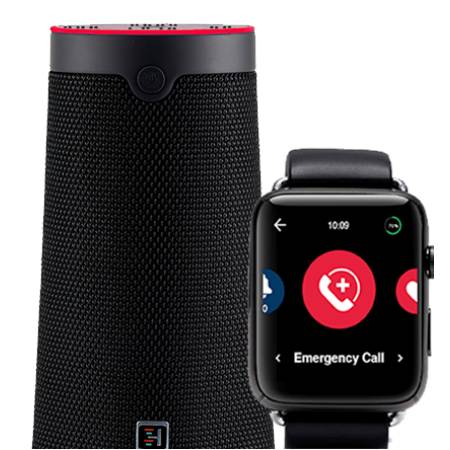
WellBe Medical Alert Plus
Our Rating:

5.0
The WellBe Medical Alert Plus is a unique medical alert system that offers both at-home and mobile emergency monitoring. It comes with a voice-enabled smart speaker and a smartwatch, both designed to provide a comprehensive safety net for users. The system is developed by HandsFree Health and is priced at $199.95 for the hardware, with a monthly service fee of $44.95.
The smart speaker serves as a virtual health assistant, providing medication, appointment, and prescription refill reminders. It can also play music, control smart home devices, and even answer general questions.
The speaker is voice-activated and uses the WellBe Voice-Enabled Virtual Health Assistant platform to provide access to a vast database of medical information. It’s activated with the phrase, “OK WellBe,” followed by your command.
The smartwatch, on the other hand, features an emergency call button with two-way talk and has a built-in heart rate monitor and a pedometer. It also uses the WellBe Voice platform and can perform most of the tasks that the speaker does, except for playing music and audiobooks. The watch is water-resistant, allowing you to wear it in the shower, and it has a GPS radio to help emergency responders pinpoint your exact location.
The WellBe Medical Alert Plus system is praised for its fast response times. In testing, the speaker system averaged a 10-second response time, and the watch averaged 15 seconds. The response agents were always professional and friendly, and two-way communications were loud and clear.
However, despite its many features, the system does have a few drawbacks. It is quite pricey, and it lacks fall detection, a feature that is often included in other medical alert systems. Despite these drawbacks, the WellBe Medical Alert Plus system is considered a solid choice for those looking for a feature-rich medical alert system.
User reviews and ratings for the WellBe Medical Alert Plus system are generally positive. Users appreciate the system’s GPS and Wi-Fi tracking abilities, which can provide peace of mind for both users and their loved ones. However, some users have expressed disappointment with the lack of fall detection, suggesting that this is an area where the system could improve.
- Features: Includes a smartwatch with an emergency call button and a smart speaker that provides medication, appointment, and prescription refill reminders. Both the smartwatch and the speaker are very quick to get you help when you need it.
- Cost and Value for Money: High cost but offers a wide range of features.
- User Reviews and Ratings: Users appreciate the system’s GPS and Wi-Fi tracking abilities.
PROS
CONS
2. Aloe Care Health
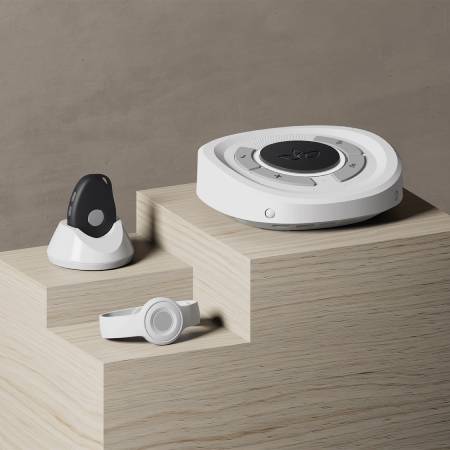
Aloe Care Health
Our Rating:

4.7
The Aloe Care Health medical alert system is a comprehensive solution that offers both at-home and mobile emergency monitoring. It is relatively new to the medical alert market but has already made a significant impact due to its unique features and user-friendly design. The system is priced at $149.99 for the hardware, with a monthly service fee of $29.99.
The system includes a smart hub base station that uses AT&T’s 4G LTE cellular service and a 1.5-inch-wide water-resistant pendant button with a 200-foot range. The smart hub is voice-activated and lets you connect to a 24/7 emergency response center using your voice or by pressing a button. It also monitors air quality, motion, and room temperature, and it lets you communicate with family members and caregivers without using your phone.
The Aloe Care Health system is known for its quick response times. In testing, it garnered an average response time of 35 seconds, and the live agents were always friendly and professional. Audio quality was superb, and push alerts arrived within seconds of a check-in request.
Despite its many features, the system does have a few drawbacks. It does not offer any add-on medical services such as the medicine reminders that you get with some other systems. However, considering the features it provides, it offers good value for money.
User reviews and ratings for the Aloe Care Health system are generally positive. Users find the system easy to set up and appreciate the quick response times. However, some users have expressed disappointment with the lack of add-on medical services, suggesting that this is an area where the system could improve.
- Features: Includes a smart hub with an emergency call button and a call button pendant with a 200-foot range. The hub monitors air quality, motion, and room temperature.
- Cost and Value for Money: Offers good value for money considering the features it provides.
- User Reviews and Ratings: Users find the system easy to set up and appreciate the quick response times.
PROS
CONS
3. Bay Alarm Medical In-Home Medical Alert
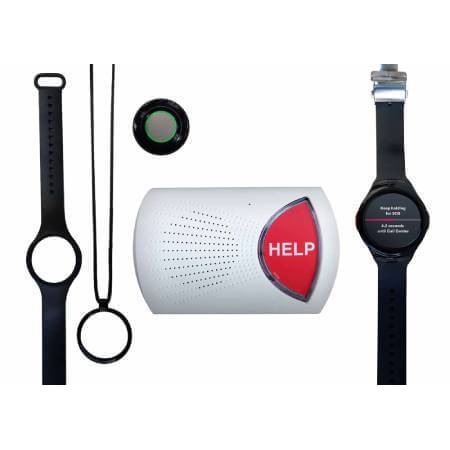
Bay Alarm Medical In-Home Medical Alert
Our Rating:

4.6
The Bay Alarm Medical In-Home Medical Alert system is a moderately priced, no-contract personal emergency response system that’s easy to install and use. It costs $19.95 per month and offers a quick response time. The system includes a base unit and a pendant help button that provides up to 1,000 feet of coverage. The base unit is equipped with a large help button and a microphone and speaker for two-way hands-free audio communication with the response center.
The system is praised for its easy installation and quick response times. In testing, it garnered an average response time of 35 seconds, which is faster than some other systems on the market. The pendant help button worked perfectly at distances of 100 to 400 feet outside of the home, providing a solid range for users.
However, there are a few drawbacks to the Bay Alarm Medical In-Home Medical Alert system. The reset button on the back of the unit is small and inconveniently located, which could lead to some confusion if the alarm is set off accidentally. Additionally, if there are two people in the house that require monitoring, you will need to purchase extra pendant or wristband buttons for an additional $1.95 per month each.
User reviews and ratings for the Bay Alarm Medical In-Home Medical Alert system are generally positive. Users appreciate the quick response times and easy installation. However, some users have expressed disappointment with the small reset button, suggesting that this is an area where the system could improve.
- Features: Easy installation, fast response times, and a reasonable monthly subscription price. Comes with a waterproof call button pendant.
- Cost and Value for Money: Reasonable monthly subscription price.
- User Reviews and Ratings: Users appreciate the quick response times and easy installation.
PROS
CONS
4. LifeFone At-Home and On-the-Go GPS Voice-in-Necklace
Best on ease of use
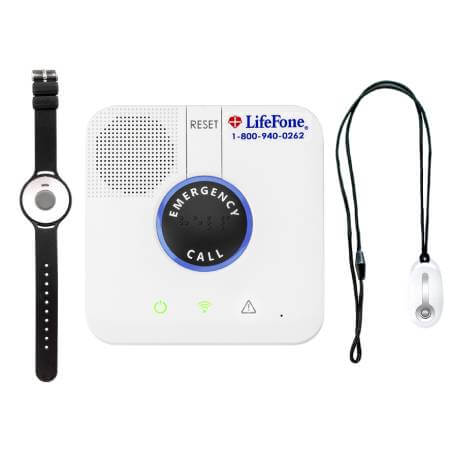
LifeFone At-Home and On-the-Go GPS Voice-in-Necklace
Our Rating:

4.7
The LifeFone At-Home and On-the-Go GPS Voice-in-Necklace is a mobile medical alert pendant that offers immediate emergency help with the push of a button, no matter where you are. This lightweight pendant uses cellular, GPS, and Wi-Fi technology to help pinpoint your exact location in the event of an emergency. The device is priced at $39.99 per month if you pay annually, but the price increases slightly if you choose to pay quarterly or monthly.
The pendant is water and dust-resistant and can be worn around your neck using the included black lanyard, or on your belt with a belt clip. It weighs in at 1.7 ounces and is slightly larger than some other devices on the market. The pendant has an IP67 rating for water and dust resistance, which means it can withstand rain, splashing, and even an accidental drop in the water.
What sets this device apart from other portable medical alert systems is its extended battery life. While some devices offer a few days of battery power, the LifeFone necklace can go up to 30 days between charges. However, if you subscribe to fall detection, battery life will be reduced to around five days.
The system is praised for its quick response times. In testing, it garnered an average response time of 25 seconds, which is faster than some other systems on the market. The pendant help button worked perfectly, providing a solid range for users.
However, there are a few drawbacks to the LifeFone At-Home and On-the-Go GPS Voice-in-Necklace system. The extra features, such as fall detection and LifeFone Protection, can get pricey. LifeFone Protection protects against loss or theft, water damage, damage from normal wear and tear, and power surges for an extra $5 per month. Fall detection also costs an extra $5 per month.
User reviews and ratings for the LifeFone At-Home and On-the-Go GPS Voice-in-Necklace system are generally positive. Users appreciate the long battery life and fast response times. However, some users have expressed disappointment with the cost of the extra features, suggesting that this is an area where the system could improve.
- Features: Lasts up to 30 days between battery charges. It uses Wi-Fi, cellular, and GPS radios to pinpoint your exact location.
- Cost and Value for Money: High cost but offers a wide range of features.
- User Reviews and Ratings: Users appreciate the long battery life and fast response times.
PROS
CONS
5. Lively Mobile Plus
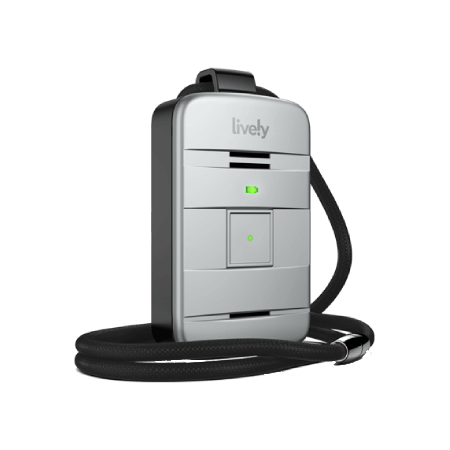
Lively Mobile Plus
Our Rating:

4.6
The Lively Mobile Plus is a wearable medical alert system that provides immediate emergency help with the push of a button. This lightweight device uses cellular, GPS, and Wi-Fi technology to help pinpoint your exact location in the event of an emergency. The device is priced at $24.99 per month if you pay annually, but the price increases slightly if you choose to pay quarterly or monthly.
The device is small and lightweight, weighing only 1.9 ounces and measuring 2.6 by 1.6 by 0.6 inches. It has a silver finish, an IPX7 waterproof rating that means it can be worn in the shower, and sports a clip on its top edge for attaching the included lanyard. There’s a square Call button in the middle of the device used to contact the emergency response center, as well as a battery indicator, a speaker, and a microphone for two-way audio with the response center.
The Lively Mobile Plus is powered by an internal rechargeable 930mAh lithium-ion battery rated to provide up to 80 hours of standby time. That’s more than twice as long as the original Lively Mobile (36 hours) and more in line with other mobile systems such as the Bay Alarm Medical Mobile GPS Help Button (72 hours), while the LifeFone At-Home and On-the-Go GPS Voice-in-Necklace offers the longest battery life we’ve seen to date (up to 30 days).
The system is praised for its quick response times. In testing, it garnered an average response time of 15 seconds, which is faster than some other systems on the market. The pendant help button worked perfectly, providing a solid range for users.
However, there are a few drawbacks to the Lively Mobile Plus system. The extra features, such as fall detection and urgent care, can get pricey. Fall detection costs an extra $5 per month, and urgent care, which provides 24/7 access to doctors and nurses for medical advice and prescription refills, costs an extra $5 per month as well.
User reviews and ratings for the Lively Mobile Plus system are generally positive. Users appreciate the fast response times and the device’s lightweight design. However, some users have expressed disappointment with the cost of the extra features, suggesting that this is an area where the system could improve.
- Features: Offers an average emergency response time of just 15 seconds. It delivered clean two-way audio in testing and correctly pinpointed my location when I was out on the road.
- Cost and Value for Money: Reasonable price for the features it offers.
- User Reviews and Ratings: Users appreciate the fast response times and the device’s lightweight design.
PROS
CONS
6. Medical Guardian MGMove Smartwatch
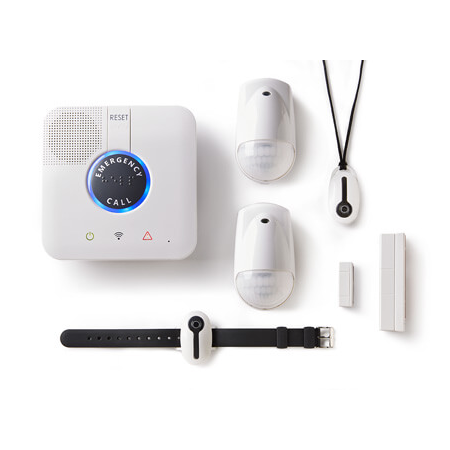
Medical Guardian MGMove Smartwatch
Our Rating:

4.6
The Medical Guardian MGMove Smartwatch is a stylish and functional medical alert system that offers a variety of features to keep users safe and connected. This device, which starts at $199.95 upfront and then $39.95 per month, provides immediate contact with an emergency response agent at the touch of a button.
The MGMove smartwatch is sleek and minimalist, with a thin glossy black bezel, full-color touch-enabled watch face, and flexible black wrist band. The watch face is 1.25 inches in diameter and has an IP67 water-resistance rating, allowing it to be worn in the rain and during showers.
The device is equipped with cellular (AT&T), GPS, and Wi-Fi radios, as well as a rechargeable battery that should last for up to 24 hours between charges. The watch audibly alerts users when it’s time to recharge.
The MGMove smartwatch offers quick response times, medicine and appointment reminders, and integrates with a caregiver app that lets members of your Support Circle (caregivers, family members, and friends) track your activities and locate you.
However, there are a few drawbacks to the MGMove smartwatch. Fall detection is not an option at any tier, and the Step Up Feature, which unlocks Support Circle reminders and messaging apps, costs an extra $5 per month.
User reviews and ratings for the Medical Guardian MGMove Smartwatch are generally positive. Users appreciate the fast response times and the device’s sleek design. However, some users have expressed disappointment with the lack of fall detection and the cost of the extra features.
- Features: Sleek design, fast response times, and robust features. In addition to an emergency call button, it has a pedometer and a handful of useful apps for messaging, reminders, and local weather conditions.
- Cost and Value for Money: High cost but offers a wide range of features.
- User Reviews and Ratings: Users appreciate the fast response times and the additional features like step counting and reminders.
PROS
CONS
7. MobileHelp Classic

MobileHelp Classic
Our Rating:

4.6
The MobileHelp Classic is a comprehensive in-home medical alert system that uses cellular technology to connect you to a 24/7 emergency response center with the press of a button. The device is priced at $29.95 per month, but you can save money with a quarterly plan ($83.85 for three months), a semi-annual plan ($159.70 for six months), or an annual plan ($324.40 for a year).
The MobileHelp Classic uses a wedge-shaped Integrity Tracking CBS2-01 cellular base station that measures 3.0 by 7.0 by 6.0 inches (HWD) and contains large Emergency and Reset buttons, a Test button, and small LCD panel that is 2.2 inches wide and 0.75 inch high. The Emergency button is backlit red and the Reset button is backlit blue, making them easy to see them in the dark.
The device is equipped with cellular (AT&T), GPS, and Wi-Fi radios, as well as a rechargeable battery that should last for up to 30 hours between charges. The watch audibly alerts users when it’s time to recharge.
The MobileHelp Classic offers quick response times, medicine and appointment reminders, and integrates with a caregiver app that lets members of your Support Circle (caregivers, family members, and friends) track your activities and locate you.
However, there are a few drawbacks to the MobileHelp Classic system. The extra features, such as fall detection and urgent care, can get pricey. Fall detection costs an extra $10 per month, and you can add wall buttons for an additional $2 per month each.
User reviews and ratings for the MobileHelp Classic system are generally positive. Users appreciate the quick response times and the easy installation process. However, some users have expressed disappointment with the cost of the extra features, suggesting that this is an area where the system could improve.
- Features: Offers several advanced features including a wearable call button pendant; cellular connectivity; a backup battery that provides up to 30 hours of power; a display panel that shows the date, time, and current room temperature; and a cellular signal strength indicator.
- Cost and Value for Money: Affordable price for the features it offers.
- User Reviews and Ratings: Users appreciate the quick response times and the easy installation process.
PROS
CONS
8. LifeStation In Home No Landline Medical Alert System

LifeStation In Home No Landline Medical Alert System
Our Rating:

4.6
The LifeStation In Home No Landline Medical Alert System is a desktop medical alert system that provides immediate contact with an emergency response agent at the touch of a button. This system, priced at $32.95 per month, uses built-in cellular connectivity and comes with a long-range help button that can be worn around the house and yard.
The LifeStation In Home system is easy to set up and use. The base station measures 2.8 by 6.0 by 6.0 inches and can be hung on a wall or placed on a desktop surface. It features a large Emergency Call button with Braille lettering, a Reset button, a speaker, a microphone, and status indicators for power, cellular connectivity, and alarm activity.
The wearable help button is waterproof and can be worn in the shower or out in the rain. It has a 600-foot range and can be worn around your neck as a pendant or on your wrist as a bracelet.
The system doesn’t rely on telephone landlines; instead, it uses AT&T’s 4G LTE network to connect you to a 24/7 emergency response center. The base station has a built-in backup battery that will continue to supply power to the device for up to 24 hours in the event of a power outage.
However, the LifeStation In Home system doesn’t offer any add-on services such as medicine reminders and wellness checks, nor does it offer a mobile app. It also doesn’t offer fall detection, which is an extra $10 per month, or a wall button or a lockbox, which are an additional $2.95 per month each.
User reviews and ratings for the LifeStation In Home No Landline Medical Alert System are generally positive. Users appreciate the fast response times and the easy installation process. However, some users have expressed disappointment with the lack of add-on services and the cost of the extra features.
- Features: Quick connection with an emergency response agent and a long-range wearable help button. The base station uses cellular technology and does not require a landline.
- Cost and Value for Money: High cost but offers a wide range of features.
- User Reviews and Ratings: Users appreciate the long-range pendant and the fast response times.
PROS
CONS
9. LifeStation Sidekick Smart
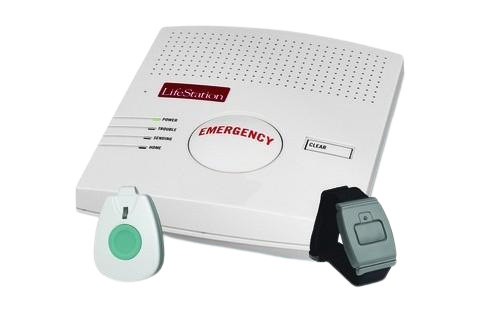
LifeStation Sidekick Smart
Our Rating:

4.6
The LifeStation Sidekick Smart is a versatile smartwatch that serves as a 24/7 medical alert device, a pedometer, and a heart rate monitor. Priced at $43.95 per month, this wearable device looks like a typical smartwatch, but can connect you with an emergency response agent at the press of a button. It also measures your heart rate and tracks your daily step count.
The Sidekick Smart is a customized EV05 Android-powered wearable made by Eview. It has a black finish and a round 1.82-inch, full-color capacitive touch display with 360-by-320-pixel resolution. It comes with a black rubber wrist band and has an IPX8 water resistance rating which means you can wear it in the shower and outside in the elements.
Onboard Bluetooth and 4G cellular radios enable a connection to the emergency response center, while GPS and Wi-Fi radios allow emergency response agents to pinpoint your exact location. A built-in pedometer keeps track of your steps, tells you how many calories you’ve burned, and records how far you travel (in feet). You can also view the local weather report from the watch.
However, the Sidekick Smart does not offer fall detection services. As with the LifeStation Sidekick device, the system also lacks a mobile app, medicine reminders, and the caregiver services you get with other mobile devices such as the Lively Mobile Plus and the MobileHelp Solo.
User reviews and ratings for the LifeStation Sidekick Smart are generally positive. Users appreciate the easy-to-use interface and the bright, colorful display. However, some users have expressed disappointment with the lack of add-on services and the cost of the extra features.
- Features: More than just a stylish medical alert watch, it has GPS and Wi-Fi radios that allow emergency response agents to pinpoint your location.
- Cost and Value for Money: High cost but offers a wide range of features.
- User Reviews and Ratings: Users appreciate the easy-to-use interface and the bright, colorful display.
PROS
CONS
Each of these systems has its own unique features, pros, and cons. It’s important to consider these factors, along with cost and user reviews, when choosing the best home medical alert system for your needs.
Factors to Consider
When choosing a medical alert system, it’s important to consider several factors. These include the type of system (in-home or mobile), the range of the device, the response time of the monitoring center, and the cost of the system.
- Type of System: Medical alert systems come in two main types: in-home systems and mobile systems. In-home systems are ideal for people who spend most of their time at home, while mobile systems are designed for those who are often on the go. Mobile systems use GPS technology to pinpoint your location and cellular technology to connect you to a response center.
- Range: The range of the device is another crucial factor. Most portable help buttons can communicate with the base unit from distances of up to 1,500 feet. However, if you live in a large home or spend a lot of time in your yard, you might need a device with a longer range.
- Response Time: The response time of the monitoring center is critical. In an emergency, every second counts, so it’s important to choose a system with a fast response time.
- Cost: The cost of the system is also a significant factor. Most medical alert systems offer monthly subscriptions, with prices varying depending on the type of system and the features it offers. Some systems might also require an upfront fee.
Understanding Your Needs
Understanding your needs is crucial when choosing a medical alert system. For example, if you have a medical condition that makes you prone to falls, you might need a system with automatic fall detection. If you often forget to take your medication, a system with medication reminders might be beneficial.
Comparing Different Systems
Before making a decision, it’s important to compare different medical alert systems. Look at the features each system offers, the cost, and the reviews from other users. Consider the pros and cons of each system to determine which one best meets your needs.
Consultation with Medical Professionals
Finally, it can be helpful to consult with medical professionals before choosing a medical alert system. They can provide valuable insights based on their experience and knowledge of your medical history and needs. They might also be able to recommend specific systems or features that would be beneficial for you.
Monthly Costs
The monthly cost of medical alert systems primarily depends on the type of system you choose and the extra features you want. Home-based systems typically cost $20 to $40 per month, while mobile systems are around $10 to $30 higher per month due to mobile services like GPS tracking and cellular coverage. There are also optional features, including automatic fall detection and wall-mounted help buttons, that can add an extra $5 to $15 per month to your plan.
Equipment Fees
In addition to monthly monitoring fees and add-ons, you’ll need to consider equipment costs. Some providers, such as Aloe Care Health, require you to purchase the equipment outright for a few hundred dollars. On the other hand, Medical Guardian and Bay Alarm Medical include equipment rentals in their monthly rates, and you can return your equipment at any time.
Activation Fees
The activation process will differ depending on the brand and system you choose. Some systems’ installation may be as easy as unpacking the box, plugging it in, and working right away – while others may require extra steps to get them working properly. If you or your family member is not tech-savvy, then it may be worthwhile to pay a professional to take care of the installation. It may add an extra $100-200 to the overall cost of the medical alert system, but will provide peace of mind that you won’t end up voiding the warranty or creating complications from the get-go after buying the device.
Price Lock Guarantee
When shopping for a medical alert system, it’s important to consider whether the company offers a price lock guarantee. This means that the price you pay when you sign up will remain the same for as long as you keep your service. Not all companies offer this guarantee, so it’s something to look out for. A price lock guarantee can provide peace of mind and make budgeting easier, as you’ll know that your monthly cost won’t increase unexpectedly.
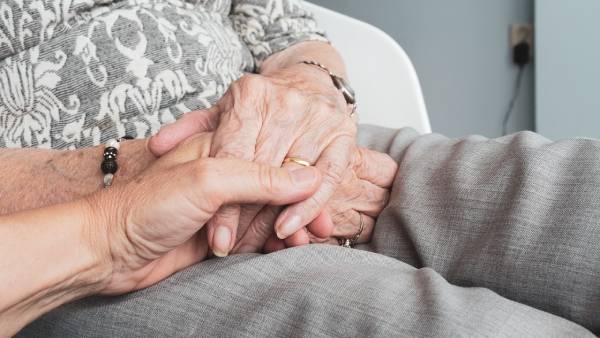
How Medical Alert Systems Contact Emergency Services
Medical alert systems are designed to provide a quick and easy way for individuals to call for help in the event of an emergency. When the help button on a medical alert device is pressed, a signal is sent to a monitoring center. The monitoring center is staffed 24/7 by trained operators who can assess the situation and contact emergency services if necessary.
The medical alert system can connect to the monitoring center through a landline, cellular network, or Wi-Fi, depending on the type of system. Some systems also have two-way communication features, allowing the user to speak directly with the operator at the monitoring center.
Response Time
The response time of a medical alert system refers to how quickly the monitoring center responds after the help button is pressed. This is a crucial factor to consider when choosing a system, as every second can count in an emergency.
Most medical alert companies aim to have a response time of less than a minute. Some companies, like Bay Alarm Medical and Medical Guardian, even advertise average response times of less than 30 seconds.
Role of Monitoring Centers
Monitoring centers play a vital role in the operation of medical alert systems. They are responsible for receiving alerts from the medical alert devices and taking appropriate action.
When an alert is received, the operator at the monitoring center will attempt to communicate with the user through the system’s two-way communication feature. If the user is able to respond, the operator can assess the situation and provide assistance as needed.
If the user is unable to respond, or if they confirm that they need help, the operator will contact emergency services. The operator can provide the user’s location and any relevant medical information to the emergency responders.
In addition to contacting emergency services, the monitoring center can also contact the user’s designated contacts, such as family members or caregivers, to inform them of the situation.
In essence, monitoring centers serve as a critical link between users and emergency services, ensuring that help is dispatched quickly and efficiently when it’s needed most.
Features Comparison
- In-Home Medical Alert Systems
- These systems work within your home and its immediate surroundings, with an average range of 400 ft to 1,200 ft from the base station.
- They consist of a base station, which is plugged into a wall and a phone jack, and a wearable emergency button, which can be worn as a pendant around the neck or as a watch on the wrist.
- In the event of a fall, the monitoring center is alerted either by the user pressing the emergency button or through automatic fall detection. If no contact with the fall victim can be made, emergency responders are dispatched immediately and family members are notified.
- Mobile Medical Alert Systems
- These systems are functional both in and outside the home. They use cellular technology in the pendant to contact and speak with the monitoring center through a two-way speakerphone. There is no base station.
- In the event of a fall outside the house, all mobile alert devices have some kind of GPS tracking technology to help responders find your location instantaneously.
- Some medical alert companies allow family members and caregivers to use the GPS technology to track their loved one live online. This can be especially useful for older adults with memory loss, confusion, or wandering issues.
Cost Comparison
- In-home medical alert systems are generally less expensive than mobile systems. The average mobile medical alert device costs an extra $10 to $15 a month more than an at-home system.
Suitability for Different Users
- If you stay in your home most of the time, the cheaper alternative of an in-home medical alert device will do just fine. Even if you do leave your home often, if you do so accompanied by a friend, family member, or caregiver, there’s no need for a mobile medical alert system.
- However, if you find that you do many outdoor activities on your own, an on-the-go medical alert system could be the perfect fit for you. Whether you go for walks, drive a car, or do daily chores on your own, a mobile medical alert system will give you the security and peace of mind of knowing help is always available.
Considerations
- Cellular Coverage: You have to make sure you get good cell reception in your home. Many medical alert companies have their system tied to a cellular network such as AT&T or Verizon. You can usually type in your address and check in advance if your home or area gets good cellular coverage.
- Battery Recharging: Just like a phone, a mobile medical alert device requires recharging every 2-3 days or so. The pendant on an in-home device can last for years. If you or your loved one find it cumbersome to remember to recharge your device, you may want to give a mobile system a second thought.
Addressing Common Myths
- Myth 1: I’ve never fallen, so why would I need one?
- Fact: According to the CDC, every second in the United States, an adult over the age of 65 suffers a fall. Twenty percent of those falls will result in serious injury, such as a broken bone. Falls can happen to anyone, and as we age, our bodies don’t bounce back as well, and the risks of a broken bone often increase. That’s why medical alerts for the elderly are a must.
- Myth 2: I don’t live alone, so I don’t need a panic button.
- Fact: While it is wonderful to have a loved one there by your side throughout the day, there might be times when you are alone. Even if you are always with someone at home, keep in mind that even the closest care of a loved one can’t prevent all falls, injuries, or medical emergencies. In fact, according to the National Council on Aging, half of all falls happen at home – and it’s safe to say that not all of those individuals were alone when the accident occurred.
- Myth 3: Aren’t those only for the elderly?
- Fact: While seniors greatly benefit from medical alert devices, they aren’t the only ones who can make good use of them. If you have a chronic medical condition, live on your own, or simply want peace of mind, the medical alert pendant keeps help literally a touch away.
- Myth 4: Medical alert technology must be expensive.
- Fact: While it seems this type of technology could be pricey, the fact is that you can get protection from Alert1 for less than one dollar a day! Button alarms are offered at a wide range of affordable prices for everyone from the person who stays at home most of the time to the person who travels the nation with aplomb.
- Myth 5: It’s not attractive.
- Fact: Today’s medical alert devices are sleek and stylish, and fit in well with any sort of attire. As for the medical alert pendant, not only is it small enough to blend in with your outfit, you can also customize it with a colorful lanyard or chain, or wear it as a bracelet.
- Myth 6: If you can’t press the button, it doesn’t matter.
- Fact: If you opt for a medical alert device with fall technology, you don’t have to press the button at all. Fall detection devices use small sensors to detect the direction and speed of the tumble, which then determines on its own that you have fallen. The fall alarm will call the Command Center on your behalf, and you will soon hear trained professionals talking to you, asking what they can do to help you.
- Myth 7: Don’t you have to know a lot about technology?
- Fact: Though medical alert devices employ advanced technology, actually using them couldn’t be simpler. Alert1 not only sends you your devices pre-programmed, but we also offer tech support, videos on our website, as well as assistance via phone if you ever need anything.
- Myth 8: The range is pretty limited.
- Fact: Systems for the home begin with a range of about 400 – 600 feet around the base unit. If you have on-the-go senior technology, you don’t have to worry about a base unit at all. You can go wherever you please inall 50 US states and know that you have 24/7 protection no matter where you are.
- Myth 9: My cell phone is all I need!
- Fact: Most of us don’t carry our cell phones with us everywhere, especially not in our own homes. You likely leave yours on the counter or table sometimes. And it’s almost certain you don’t take it into the shower with you, because most cell phones would be ruined! The good news is that you can have your emergency alarms for seniors comfortably on your person at all times. And our medical alert pendant is showerproof, so you can take it into the shower with you – something you wouldn’t dare try with that cell phone.
- Myth 10: If I Have a Caregiver, I Don’t Need a Medical Alert
- Fact: Family caregivers all over the world help their loved ones with aging in place solutions every day. That includes home modifications for the elderly, fall prevention strategies, and care of senior health and wellness. According to a 2020 survey by The Senior List, caregivers list medical alert systems as the top item they would recommend for senior safety.

Facts about Medical Alert Systems
- Medical alert systems are not just for the elderly. They can be beneficial for anyone with a chronic medical condition, those who live alone, or those who simply want peace of mind.
- Medical alert systems are not necessarily expensive. Many providers offer affordable options, making these systems accessible to a wide range of individuals.
- Medical alert systems are not unattractive or cumbersome. Many modern systems are sleek, stylish, and can be worn as a bracelet, pendant, or watch.
- Medical alert systems do not require extensive technical knowledge to operate. Most systems are designed to be user-friendly and come with support and assistance if needed.
- Medical alert systems are not limited to a short range. Many systems offer a range of 400-600 feet around the base unit, and mobile systems offer protection anywhere in the country.
- Medical alert systems are not redundant if you have a cell phone. In fact, they offer certain advantages over cell phones, such as being wearable and showerproof.
- Even if you have a caregiver, a medical alert system can still be a valuable tool for ensuring safety and quick response in the event of an emergency.
FAQs on Best Rated Home Medical Alert Systems
Medical alert systems are a crucial lifeline for seniors and people with certain health conditions. They provide a sense of security and independence, knowing that help is just a button press away. Here are some frequently asked questions about these systems:
What is an “on-the-go” system in medical alert?
An on-the-go system is a mobile medical alert system designed for active individuals. These systems use cellular technology and often include GPS tracking, allowing users to call for help from anywhere, not just within their homes.
What services do medical alert providers offer?
Medical alert services typically include 24/7 monitoring, two-way communication, automatic fall detection, GPS location tracking, and more. Some providers also offer additional services like medication reminders, wellness checks, and caregiver tools.
What is a fall detection device?
A fall detection device is a wearable device that automatically detects falls. If a fall is detected, the device automatically sends an alert to the monitoring center, even if the user is unable to press the alert button.
What is the cost of medical alert systems?
The cost of medical alert systems varies depending on the provider and the features included. Monthly monitoring fees can range from around $20 to over $50. Some providers also charge for equipment or activation fees.
What is a GPS medical alert system?
A GPS medical alert system uses GPS technology to track the user’s location. This is especially useful in emergencies when the user is away from home or unable to communicate their location.
What is a cellular medical alert system?
A cellular medical alert system uses cellular networks to connect the user to the monitoring center. This means it does not require a landline and can work anywhere thereHere are some FAQs incorporating the provided keywords:
What is a monitored medical alert systems?
A monitored medical alert system is a device that connects the user to a 24/7 monitoring center. When the user presses the alert button, the system sends a signal to the monitoring center, where trained operators can assess the situation and dispatch emergency services if necessary.
What are the benefits of a monitored medical alert system over an unmonitored system?
The main advantage of a monitored medical alert system is that it provides immediate access to help 24/7. In an emergency, the user can press the alert button to connect with a monitoring center. The operator can then assess the situation and dispatch emergency services if needed. Unmonitored systems, on the other hand, only dial pre-set phone numbers and do not connect to a monitoring center.
Who are the typical users of medical alert systems?
Medical alert system users are typically seniors or individuals with health conditions that make them prone to falls or medical emergencies. However, anyone who lives alone or is at risk of medical emergencies can benefit from a medical alert system.
What is a medical alert mobile system?
A medical alert mobile system is a portable device that works anywhere there’s cellular coverage. These systems often include features like GPS tracking, allowing users to call for help from anywhere.
What is a wearable medical alert device?
A wearable medical alert device is a device that the user wears, like a pendant or wristband, that has a button to press in case of an emergency. Some wearable devices also include automatic fall detection, which can send an alert even if the user is unable to press the button.
Conclusion and Final Thoughts
In this comprehensive guide, we have delved deep into the world of medical alert systems, exploring their importance, features, and the top-rated options available in the market. We’ve also discussed how to choose the right system, the costs involved, and the role these systems play in emergency services. We’ve compared home medical alert systems and mobile medical alert systems, busted common myths, and answered frequently asked questions.
Recap of the Information Provided
- Medical alert systems are vital tools that provide immediate assistance during emergencies, especially for seniors and people with certain health conditions. They typically consist of a base station and a wearable device, and when the help button is pressed, the system signals the monitoring center for help.
- The best rated home medical alert systems come with features like automatic fall detection, GPS location tracking, medication reminders, and long battery life. They also include a wearable device for convenience.
- When choosing a medical alert system, it’s important to consider factors such as your needs, the features of different systems, and consultation with medical professionals.
- The cost of a medical alert system varies, but they typically cost around $1 a day. There are no hidden fees, no long-term contracts, and some providers offer a price lock guarantee.
- Medical alert systems play a crucial role in emergency services. They contact emergency services when the help button is pressed, and the response time is typically quick.
- Home medical alert systems and mobile medical alert systems have their own set of features and costs, and the suitability depends on the user’s lifestyle and needs.
- There are several myths and misconceptions about medical alert systems, but it’s important to separate fact from fiction to make an informed decision.
- Lastly, we’ve answered some commonly asked questions about medical alert systems to provide a better understanding of these life-saving devices.
Importance of Choosing the Right System
Choosing the right medical alert system is a decision that should not be taken lightly. It’s not just about the features or the cost, but also about the peace of mind and security it provides. The right system can be a lifeline in emergencies, providing immediate assistance when it’s most needed.
Encouragement for Further Research
While we’ve tried to provide a comprehensive guide on medical alert systems, we encourage you to do further research. Every individual’s needs are unique, and what works for one person might not work for another. Consider your lifestyle, health condition, and personal preferences when choosing a system. Consult with medical professionals and read user reviews to make an informed decision.
In conclusion, medical alert systems are more than just devices; they are a commitment to safety and independence. Whether you’re a senior living alone, a person with a health condition, or someone who values the security of knowing help is at hand, a medical alert system can be a valuable investment. Remember, the right system can make all the difference in an emergency, so choose wisely.
